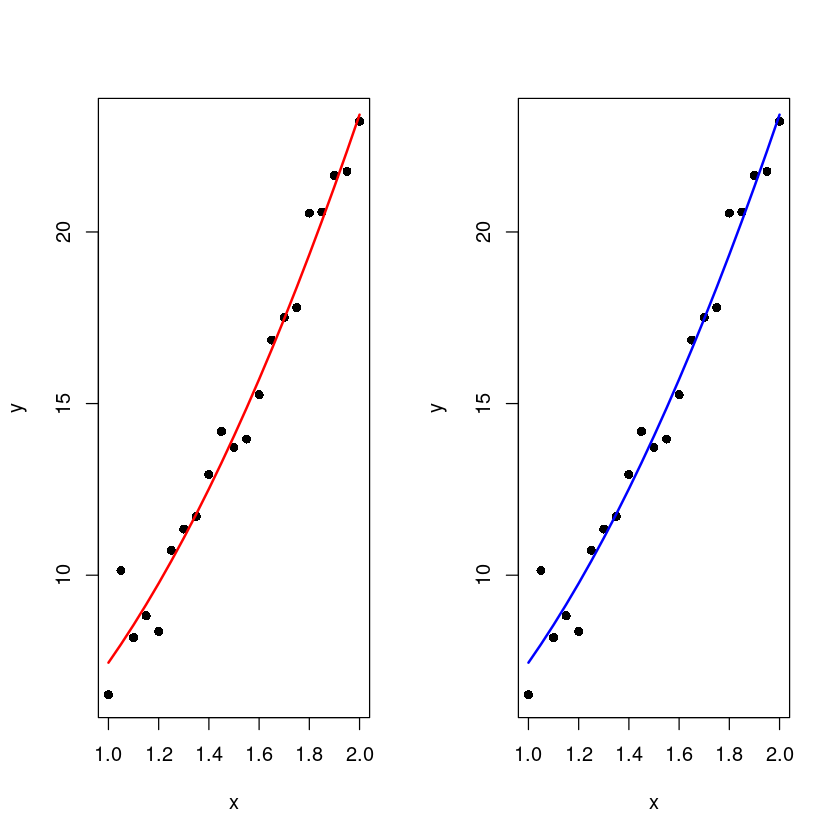hard <- read.csv("hardwood.csv")
head(hard)| x | y | |
|---|---|---|
| <dbl> | <dbl> | |
| 1 | 1.0 | 6.3 |
| 2 | 1.5 | 11.1 |
| 3 | 2.0 | 20.0 |
| 4 | 3.0 | 24.0 |
| 5 | 4.0 | 26.1 |
| 6 | 4.5 | 30.0 |
김보람
May 25, 2023
해당 자료는 전북대학교 이영미 교수님 2023응용통계학 자료임
| x | y | |
|---|---|---|
| <dbl> | <dbl> | |
| 1 | 1.0 | 6.3 |
| 2 | 1.5 | 11.1 |
| 3 | 2.0 | 20.0 |
| 4 | 3.0 | 24.0 |
| 5 | 4.0 | 26.1 |
| 6 | 4.5 | 30.0 |
\(y = β_0 + β_1x + ϵ\)
\(y = β_0 + β_1(x − \bar x) + ϵ\)
Call:
lm(formula = y ~ x, data = hard)
Residuals:
Min 1Q Median 3Q Max
-25.986 -3.749 2.938 7.675 15.840
Coefficients:
Estimate Std. Error t value Pr(>|t|)
(Intercept) 21.3213 5.4302 3.926 0.00109 **
x 1.7710 0.6478 2.734 0.01414 *
---
Signif. codes: 0 ‘***’ 0.001 ‘**’ 0.01 ‘*’ 0.05 ‘.’ 0.1 ‘ ’ 1
Residual standard error: 11.82 on 17 degrees of freedom
Multiple R-squared: 0.3054, Adjusted R-squared: 0.2645
F-statistic: 7.474 on 1 and 17 DF, p-value: 0.01414\(y= \beta_0+\beta_1x + \beta_2 x^2 + \epsilon\)
Call:
lm(formula = y ~ x + I(x^2), data = hard)
Residuals:
Min 1Q Median 3Q Max
-5.8503 -3.2482 -0.7267 4.1350 6.5506
Coefficients:
Estimate Std. Error t value Pr(>|t|)
(Intercept) -6.67419 3.39971 -1.963 0.0673 .
x 11.76401 1.00278 11.731 2.85e-09 ***
I(x^2) -0.63455 0.06179 -10.270 1.89e-08 ***
---
Signif. codes: 0 ‘***’ 0.001 ‘**’ 0.01 ‘*’ 0.05 ‘.’ 0.1 ‘ ’ 1
Residual standard error: 4.42 on 16 degrees of freedom
Multiple R-squared: 0.9085, Adjusted R-squared: 0.8971
F-statistic: 79.43 on 2 and 16 DF, p-value: 4.912e-09\(y= \beta_0+\beta_1cx + \beta_2 cx^2 + \epsilon\)
Call:
lm(formula = y ~ cx + I(cx^2), data = hard)
Residuals:
Min 1Q Median 3Q Max
-5.8503 -3.2482 -0.7267 4.1350 6.5506
Coefficients:
Estimate Std. Error t value Pr(>|t|)
(Intercept) 45.29497 1.48287 30.55 1.29e-15 ***
cx 2.54634 0.25384 10.03 2.63e-08 ***
I(cx^2) -0.63455 0.06179 -10.27 1.89e-08 ***
---
Signif. codes: 0 ‘***’ 0.001 ‘**’ 0.01 ‘*’ 0.05 ‘.’ 0.1 ‘ ’ 1
Residual standard error: 4.42 on 16 degrees of freedom
Multiple R-squared: 0.9085, Adjusted R-squared: 0.8971
F-statistic: 79.43 on 2 and 16 DF, p-value: 4.912e-09모형의 적합도는 동일한 값이 나온다.
기울기가 조금 다르게 나온다.
\(\beta_2\)는 동일하게 나오지만, \(\beta_0,\beta_1\)이 조금 다르게 나온다.
standard error가 좀 다르게 나온다.
plot(y~x, hard, pch=16, main="scatter plot : hardwood")
abline(hard_fit, col='blue', lwd=2)
lines(hard$x, fitted(hard_fit_c_2),col='red', lwd=2)
legend("topleft", c("x","cx+cx^2"), col=c('blue','red'), lwd=2, lty=1)
par(mfrow=c(1,2))
plot(fitted(hard_fit), rstandard(hard_fit), pch =16,
xlab = expression(hat(y)),
ylab = "Standardized Residuals",
main ="Fitted vs. Residuals")
abline(h =0, col ="grey", lwd =2, lty=2)
plot(fitted(hard_fit_c_2), rstandard(hard_fit_c_2), pch =16,
xlab = expression(hat(y)),
ylab = "Standardized Residuals",
main = "Fitted vs. Residuals")
abline(h = 0, col ="grey", lwd =2, lty=2)
par(mfrow=c(1,1))
plot(y~x, hard, pch=16, main="scatter plot : hardwood")
lines(hard$x, fitted(hard_fit_c_2),col='red', lwd=2)
lines(hard$x, fitted(lm(y~cx+I(cx^2)+I(cx^3), hard)),col='blue', lwd=2)
legend("topleft",c(expression(ldots+cx^2),
expression(ldots+cx^3)), col=c('blue', 'red'), lwd=2, lty=1, bty = "n") 
plot(y~x, hard, pch=16, main="scatter plot : hardwood")
lines(hard$x, fitted(lm(y~cx+I(cx^2)+I(cx^3), hard)),col='blue', lwd=2)
lines(hard$x, fitted(lm(y~cx+I(cx^2)+I(cx^3)+I(cx^4)+I(cx^5), hard)),col='red', lwd=2)
legend("topleft", c(expression(ldots+cx^3),
expression(ldots+cx^5)), col=c('blue', 'red'), lwd=2, lty=1, bty = "n") 
Call:
lm(formula = y ~ cx + I(cx^2) + I(cx^3) + I(cx^4) + I(cx^5),
data = hard)
Residuals:
Min 1Q Median 3Q Max
-2.65167 -0.91159 -0.03811 0.96396 2.56865
Coefficients:
Estimate Std. Error t value Pr(>|t|)
(Intercept) 43.6187788 0.7309210 59.676 < 2e-16 ***
cx 5.3479308 0.3896655 13.724 4.11e-09 ***
I(cx^2) -0.1378567 0.1059263 -1.301 0.215700
I(cx^3) -0.1630817 0.0289147 -5.640 8.06e-05 ***
I(cx^4) -0.0114448 0.0026525 -4.315 0.000840 ***
I(cx^5) 0.0021978 0.0005163 4.257 0.000935 ***
---
Signif. codes: 0 ‘***’ 0.001 ‘**’ 0.01 ‘*’ 0.05 ‘.’ 0.1 ‘ ’ 1
Residual standard error: 1.703 on 13 degrees of freedom
Multiple R-squared: 0.989, Adjusted R-squared: 0.9847
F-statistic: 233.1 on 5 and 13 DF, p-value: 3.022e-121~2까지의 X의 범위 일부분
커브는 보이지 않고 직선 형태로만 보인다.
Call:
lm(formula = y ~ x + x2)
Residuals:
Min 1Q Median 3Q Max
-1.40039 -0.44786 -0.07384 0.31824 2.14916
Coefficients:
Estimate Std. Error t value Pr(>|t|)
(Intercept) 2.5112 4.8813 0.514 0.6132
x -0.5728 6.6908 -0.086 0.9327
x2 5.5131 2.2213 2.482 0.0232 *
---
Signif. codes: 0 ‘***’ 0.001 ‘**’ 0.01 ‘*’ 0.05 ‘.’ 0.1 ‘ ’ 1
Residual standard error: 0.8317 on 18 degrees of freedom
Multiple R-squared: 0.9755, Adjusted R-squared: 0.9727
F-statistic: 357.8 on 2 and 18 DF, p-value: 3.226e-15\(y=\beta_0+\beta_1x+\beta_2x^2+\epsilon\)
모형자체는 유의하게 나오지만 x와 계수는 유의하지 않고, x2는 적게 나옴 -> 다중공산성
Call:
lm(formula = y ~ cx + I(cx^2))
Residuals:
Min 1Q Median 3Q Max
-1.40039 -0.44786 -0.07384 0.31824 2.14916
Coefficients:
Estimate Std. Error t value Pr(>|t|)
(Intercept) 14.0565 0.2728 51.533 < 2e-16 ***
cx 15.9665 0.5995 26.634 6.53e-16 ***
I(cx^2) 5.5131 2.2213 2.482 0.0232 *
---
Signif. codes: 0 ‘***’ 0.001 ‘**’ 0.01 ‘*’ 0.05 ‘.’ 0.1 ‘ ’ 1
Residual standard error: 0.8317 on 18 degrees of freedom
Multiple R-squared: 0.9755, Adjusted R-squared: 0.9727
F-statistic: 357.8 on 2 and 18 DF, p-value: 3.226e-15\(y=\beta_0+\beta_1(x-\bar x) + \beta_2 (x-\bar x)^2 + \epsilon\)
\(\because x- \bar x = cx\)
\(lm(y\)~\(x+x\)^\(2)\) 이건 성립이 안된다.
\(lm(y\)~ \(x+I(x\)^\(2))\)이렇게 써야해
\(\hat \beta_2\)는 위의 m1모형의 값과 같다.
\(\hat \beta_1\)과 \(\hat \beta_0\)은 m1모형의 값과 아주 다르다.
par(mfrow=c(1,2))
plot(x,y, pch=16)
lines(x, fitted(m), col='red', lwd=2)
plot(x,y, pch=16)
lines(x, fitted(m2), col='blue', lwd=2)
\(y=\beta_0+\beta_1(x_1 - \bar x) +\epsilon\)
\(= \beta_0+\beta_1x_1 - \beta_1 \bar x + \epsilon\)
\(=(\beta_0 - \beta_1 \bar x) +\beta_1 x_1 +\epsilon\)
\(= \beta^`_0 + \beta_1x_1 + \epsilon\)
\(y=\beta_0+\beta_1(x-\bar x)+\beta_2(x-\bar x)^2\)
\(=\beta_0+\beta_1x - \beta_1 \bar x + \beta_2 x^2 - 2x \bar x \beta + \beta_2 (\bar x)^2\)
\(=((\beta_0-\beta_1 \bar x) + \beta_2 (\bar x)^2)+ (\beta_1 - 2 \bar x \beta_2) x + \beta_2 x^2\)